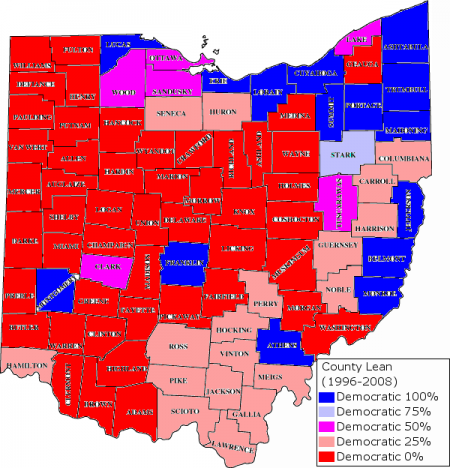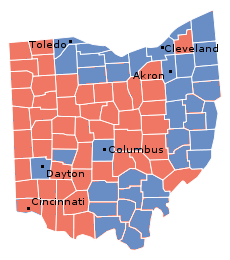By: Inoljt, http://thepolitikalblog.wordpr…
Like most states, Ohio contains several swing areas. Some lean Democratic; others lean Republican. A good politician will usually pick up most of these regions on his or her way to victory.
Swing Ohio
The following map provides a sense of swing Ohio.

Providing balance, the map encompasses two solid Democratic victories and two solid Republican victories. Bearing this in mind, one can readily make out the structural ‘7’ of Ohio politics. Absent three counties, swing Ohio roughly encompasses the outer edges of Ohio’s northern and eastern borders, creating a shape that resembles the number ‘7.’ Strong Democrats win these swing counties and fatten the ‘7.’ Strong Republicans do the inverse.
Let’s look again at Bill Clinton’s 1996 victory.

As noted previously, Clinton is creating a fat ‘7’ in his re-election.
There are several other things that should be observed about Clinton’s victory with regard to swing Ohio. At the bottom of the state, Clinton is winning a group of thinly populated, Appalachian counties. One of these counties is Athens County, home to Ohio State University; it is reliably liberal due to the college. The rest lean Republican. A strong traditional Democrat can and often will win southeast Ohio; if this happens, his Republican opponent is probably going down to defeat.
Bill Clinton is also winning three counties surrounded by red. One of these – Dayton – is the Democratic equivalent of southeast Ohio: it leans Democratic but will occasionally turn up on the other side. In that case the Republican will soon be receiving a concession call.
The other two counties are moving in opposite directions. In Clinton’s day, Clark County – Springfield – and Columbus were two cities squarely in Ohio’s swing category. Since then, however, Springfield has been drifting right: Gore won the county, Kerry and Obama lost it. Meanwhile, Columbus has been doing a hard swing left, so that neither it nor Springfield are swing regions anymore.
Finally, one may note that many places I define as “swing” are colored light red, rather than purple in the first map. This was because of Barack Obama’s peculiar performance in Ohio. The president won the state with an unconventional coalition: he lost much of swing Ohio and made up for it by performing extremely well in Columbus, Cincinnati, and northern Ohio. Whether this coalition was unique to 2008 or foreshadows a structural shift in Ohio is unknown. Personally, I prefer the former explanation.
I wonder if that means we’ll see the same pattern in 2012. I would imagine so.
A lot of your analysis so far has concentrated on southeastern Ohio, which I guess makes sense because it is the traditional swing region of the state. But again, as you said, that area is very thinly populated outside of a few counties (Ross County/Chillicothe and Scioto County/Portsmouth come to mind). It’s not incredibly important for a Democrat to win there so long as he/she can carry Toledo, Cleveland, and Columbus by wide margins, and carry Cincinnati outright. It sounds to me that you’re not incredibly bullish that a traditional Democrat can win in Cincinnati/Hamilton County, that Obama had a unique strength there. It’s true that minority turnout was way up in Hamilton County in 2008, but what I wonder is if Obama was so strong in Cincinnati, why did he struggle in Dayton? Dayton is another minority-laden city where he should have fared very well, yet he barely outdid Kerry’s numbers.
In general, I think it’s important to point out that most of the counties painted in pink were not won by Obama in 2008 (sans Hamilton) but were only razor-thin losses. Clark, Scioto, Pike, Ross, Perry, Hocking, Columbiana, Guernsey, Carroll, and Harrison counties were all lost by 10% or less, with a bunch of those being in the 1-2% range. So it wasn’t the electoral wipeout in SE Ohio that you sometimes make it out to be.
Note: Ohio State University is in Columbus. You must be confusing it with Ohio University, which is in Athens. If you go looking for Buckeyes in Athens, you’ll quickly be surrounding by wild packs of Bobcats.
that should be discussed further, Hamilton County and Cincinnati. Obama was the first Democrat to win Hamilton County since 1964.
I think the Obama coalition is the new way for the Democrats in Ohio to win. It is not unique to 2008 anymore than FDR’s New Deal coalition was to the mid 1930s.